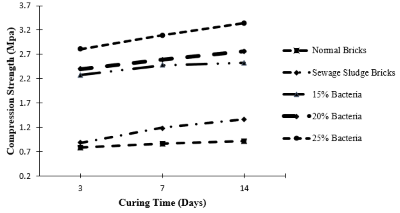The Compressive Strength of Unfired Clay Brick with MICP Reinforcement
DOI:
https://doi.org/10.24036/cived.v11i3.637Keywords:
Sewage Sludge, Bricks, Bacteria Bacillus HuizhouensisAbstract
Industrial waste in the form of sewage sludge, which is often overlooked, can have significant environmental impacts, especially polluting groundwater and surface water sources. This pollution leads to degradation of water quality, reduces the availability of clean water, and affects ecosystems. To reduce these impacts, sewage sludge can be utilized in the manufacture of construction materials, such as bricks, which is considered an economical and environmentally friendly solution. Fireless brick making, in accordance with the concept of green building, avoids air pollution from the firing process. This study explores the use of Bacillus huizhouensis bacteria in the Microbially Induced Calcite Precipitation (MICP) method to improve the strength of fireless bricks. Bacillus huizhouensis, which can hydrolyze urea and produce calcium carbonate (CaCO₃) or calcite, was chosen for its ability to produce CaCO₃ under alkaline conditions. Bacillus Huizhouensis bacteria were used to strengthen bricks with 15%, 20%, and 25% bacteria concentration variations with culture ages of 8 hours, 10 hours, and 15 hours. The results showed that the addition of 15% sewage sludge and 25% Bacillus huizhouensis bacterial solution with a culture age of 10 hours produced the highest compressive strength of 34.20 Kg/cm² (3.35 MPa), compared to sewage sludge bricks without bacteria (13.87 Kg/cm² or 1.36 MPa). Although showing significant improvement, this value is still below the SNI 15-2094-2000 standard of 50 Kg/cm² (5 MPa).
Downloads
References
Afianto, B .(2023). Pengaruh Limbah Lumpur terhadap Lingkungan di PDAM Sidoarjo Cabang IPA Krian Effect of Sewage Sludge on the Environment at PDAM Sidoarjo Krian IPA Branch. Studi Hukum, P. 202040100111.
Apriani, I., Sutrisno, H. and Dini, M. (2023). Pemanfaatan Limbah Lumpur PDAM Gunung Poteng Kota Singkawang Sebagai Bahan Pengganti Tanah Liat Pada Pembuatan Batu Bata. Jurnal Ilmu Teknik Lingkungan, 21(1).
W, Bambang, Artaningsih, N. K. A. (2021). Optimasi Semen Pada Pembuatan Batu Bata Tanpa Bakar. Cement Optimation On Bricks Making Without Burners.
Billah, A. S., Indriani, A, M,. Utomo, G. (2023). Pengaruh Bakteri Bacillus Subtilis Terhadap Kekuatan Batu Bata Menggunakan Lumpur Limbah IPA. Gradasi, J., & Sipil, T. 7(2), 202–210.
Zulaika, E., Utomo, M. A. P., Pangestu, A. S., Alami, N. H., Shovitri, M., Prasetyo, E. N., Setiawan, E., Luqman, A., Dwianita Kuswytasari, N., & Irawan, C. (2021). Novel carbonatogenic bacterial strain isolated from limestone quarry in east java, indonesia to improve concrete performance. Biodiversitas, 22(9), 3890–3898. https://doi.org/10.13057/biodiv/d220935
Marini Indriani, A., Utomo, G. and Syahputra, R. (2023). Pengaruh Siklus Basah Kering terhadap Perilaku Mekanik Tanah Lempung Stabilisasi Biosementasi dengan Bakteri Bacillus Subtilis, Cived, 10(2), pp. 2622–6774.
Indriani, A.M., Utomo, G. and Ryka, H. (2022). The Effect Of Microbially Induced Calcite Precipitation (Micp) On Shear Strength Of Coal Contaminated Soil, pp. 28–32.
Prayuda, H., Setyawan, E. A., & Saleh, F. (2018). Analisis Sifat Fisik Dan Mekanik Batu Bata Merah Di Yogyakarta (Analysis Physical and mechanical attributes of masonry in Yogyakarta). Jurnal Riset Rekayasa Sipil, 1(2).
Ni'am, A. Y., & Wardhono, A. (2017). Pengaruh treatment lumpur Lapindo terhadap mutu batu bata bahan lumpur Lapindo berdasarkan SNI 15-2094-2000. Rekayasa Teknik Sipil, Vol. 01(01/rekat/17), 136-143.
Ignatius Ren Kai Phang, Kwong Soon Wong, Yen San Chan, Sie Yon Lau (2022).
Effect of microbial‑induced calcite precipitation towards strength and permeability of pea. https://doi.org/10.1007/s10064-022-02790-0.
Karunagaran, D. (2014). Eco Friendly Brick Produced by the Reaction of Bacteria. In SSRG International Journal of Chemical Engineering Research (Vol. 1). www.internationaljournalssrg.org
Indriani, A. M., Harianto, T., Djamaluddin, A. R., & Arsyad, A. (2021). Bioremediation Of Coal Contaminated Soil As The Road Foundations Layer. International Journal Of Geomate, 21(84), 76–84.
Hasriana, Samang, L., Djide, M. N., & Harianto, T. (2018). A study on clay soil improvement with Bacillus subtilis bacteria as the road subbase layer. International Journal of GEOMATE, 15(52), 114–120. https://doi.org/10.21660/2018.52.97143.
Widjajakusuma, J., Sugata, M., Changgrawinata, A., Jap, L., Zacharia, A., & Tan, T. J. (2019). Study On Tropical Organic Soil Stabilization Based On Biogrouting. Iop Conference Series: Materials Science And Engineering, 620(1), 1–7. https://doi.org/10.1088/1757-899x/620/1/012032
Alkadri, Djamaluddin, R., Harianto, T., & Arsyad, A. (2022). Pengaruh Biosementasi Bakteri Terhadap Karakteristik Campuran Tanah Kohesif Dan Organik. Prosiding Seminar Nasional Teknik Sipil, 227–232

Downloads
Published
Issue
Section
License
Copyright (c) 2024 Zaerima Zahira Ochtharima, Andi Marini Indriani, Gunaedy Utomo, Maslina

This work is licensed under a Creative Commons Attribution 4.0 International License.

